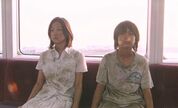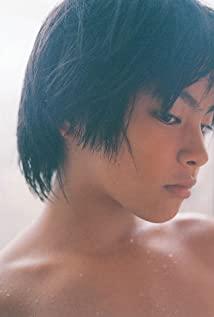In the film adaptation of Yoshie Hirokazu, the box has been an important prop from the beginning. Single mother Keiko Fukushima took her 12-year-old son Ming to visit her neighbors in her new home. She said that the father of the child was working abroad and Ming Elementary School was about to graduate with good grades. But when I got home, I opened a few suitcases on the tatami, and there were two children curled up inside! 5-year-old Mao and 3-year-old Xiaoxue chuckled and crawled out of the box, and the family arranged their new home happily. It was getting dark, and my brother found the 11-year-old sister Kyoko at the train station. The siblings sneaked back to the apartment while it was dark, reunited with their families, and ate instant noodles around the table. The warm orange lights, the mother's loving smile, the children's bright and excited eyes-what a peculiar family this is.
Such an opening strongly mobilized my curiosity: Are these children orphans picked up? Mom lives on the government welfare of the children? Cases of child abuse and confinement?
The development of the event is not as simple as I guessed. Although the mother Keiko played by You is not lacking in selfishness, her love for children is also very real. She will bring delicious sushi to the children home after get off work. She combs her little daughter’s hair. The children also have a lot of toys to pass the days when they can’t go out. Keiko’s first departure was temporary. Although she could not return home as scheduled, she eventually returned; and it was here that her abnormal relationship with her children first emerged from the dictation of her ex-boyfriend. But Hirokazu Kee did not focus his narrative on explaining the cause and effect. His perspective is very far, and the biology report observes the life of the family in a calm and meticulous manner; but the mood of the movie is not cold, and the large-scale pictures are left. Daily fun for the four children: the green plants grown in the bowl of instant noodles on the balcony, the little brother Mao who secretly crosses the border to pick toys and play with the little pride, the little red shoes of the squeaky little sister Xiaoxue, Kyoko's beautiful red piano, and Sunlight, transparent and warm sunlight everywhere.
Even if the situation took a turn for the worse, he would never be sensational. It seemed that everything was no big deal. It seemed that everything happened naturally, and there was nothing to fuss about. The pressure and frustration faced by the eldest Ziming are all demonstrated through an extremely restrained inadvertent exposure method. He will be frustrated because his friends do not want to play in a messy home. He also suspects his mother's abandonment of them, but he is showing When survival is difficult, the focus of the lens is still the excitement and joy after he and his brother got expired sushi from the convenience store, and the carefree and carefree playing with his brothers and sisters in the park, the classical guitar accompanied by the Gontiti band. The sound of the piano is still so clean and fresh, as if in the child's innocent world, the reality will shrink no matter how it is, and how it can be temporarily forgotten.
The only straightforward emotional catharsis in the film is still inseparable from the box. Ming and friend Saki dragged the little corpse in the box to the airport for burial. Two teenage children, with mud on their white clothes, walked from the darkness without saying a word to the dawn of Weixi in the empty morning. At dawn, the song of "Treasures" rang in my ears: "The late spring light makes people take a deep breath... I grow up gradually, and no one can get close..."
This is the only thing that made me cry in the whole film. Place, but even the tears will eventually converge. Because what Hirokazu Eede wants to express through "Nobody Knows" is not only sympathy for the children, or complaints against the negligent mother Keiko, he used bright and warm lens language and those trivial details of life to present the most to the whole society. A sharp, even completely unsolvable problem: how to make up for the rift between social welfare intervention and family rights? How to deal with this special case where brothers and sisters do not want to separate? How to identify family abandonment early and avoid tragedies?
Such a convergent attitude is naturally derived from rationality, but more importantly, it is the art of "Fire of Calm" that Zhi Hiro and well-known. The more calm the surface is, the more turbulent the emotions inside, and the more venting port is. moving. This kind of sentimentality is like a long and narrow black undercurrent. It envelops the fatigue and hardships of life, soaks in the injustice and misery of the world. It carries too many unanswerable doubts and too many sorrows that are difficult to resolve. It is on the surface of prosperity. The next flowed silently into the distance, darkening the sad night.
[Juvenile Crime Series]
"Lake of Eden": The Origin of Violence
http://aixiaoke.blog.163.com/blog/static/115553544201022024116893/
"Harry Brown": Use violence to control violence
http://aixiaoke.blog.163.com/blog/static/11555354420102210544740/
"White Ribbon" : The development of violence
http://aixiaoke.blog.163.com/blog/static/11555354420102242429780/
"Nobody Knows": The Black River
http://aixiaoke.blog.163.com/blog/static/11555354420103294019829/
"The Forgotten Man": The Forgotten Class
http://aixiaoke.blog.163.com/blog/static/11555354420103691734721/
View more about Nobody Knows reviews









